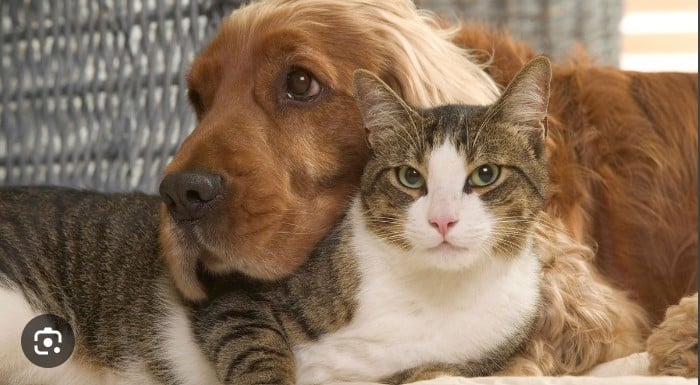Curiosity often arises among pet owners and animal enthusiasts regarding the possibility of a dog getting a cat pregnant. “Can a Dog get a Cat Pregnant?” is the topic this article seeks to address. We looked at the reproductive anatomy of cats and dogs as well as species specificity in reproduction. Furthermore, we discussed Rare Instances of Hybridization and notable instances where different animals cross-bred. Read on to find out if your dog can get your cat pregnant.
Dogs and cats belong to distinct species within the animal kingdom. While they share certain similarities in terms of domestication and living alongside humans, their reproductive systems are inherently different. Dogs are classified as Canis lupus familiaris, while cats are classified as Felis catus. Despite their proximity as household pets, their genetic makeup and reproductive mechanisms set them apart.
Species Specificity in Reproduction
Species specificity is a fundamental concept in biology. It refers to the biological principle that organisms are only capable of reproducing with members of their own species. Dogs and cats, as distinct species, adhere to this principle, making the likelihood of interbreeding highly improbable. This concept serves as a natural barrier to interspecies mating and reproduction. This concept is rooted in the genetic divergence and evolutionary history of different species, which have led to reproductive mechanisms that are finely tuned to ensure the continuation of each species. To answer your question, can a dog get a cat pregnant, continue reading the article.
See also: Can I Gift Someone a Pet like Dog or Cat?

Reproductive Anatomy of Cats and Dogs
A crucial factor in determining the feasibility of interspecies mating is the reproductive anatomy of dogs and cats. Dogs and cats have distinct genitalia designed for copulation within their respective species. Male dogs possess a penile structure suited for mating with female dogs. Male cats have a different reproductive anatomy tailored for mating with female cats. Similarly, reproductive organs of female dogs and cats are specialized for receiving sperm from male members of their own species. These anatomical differences highlight evolutionary adaptations. They shape reproductive systems of dogs and cats. The adaptations facilitate mating within their respective species.
Behavioral Dynamics and Instinctual Drives
In addition to anatomical differences, behavioral dynamics and instinctual drives play a significant role in governing mating behaviors among animals. Although dogs and cats may coexist harmoniously in a household setting, their mating behaviors are governed by instinctual drives and biological imperatives. Male dogs exhibit courtship rituals and mating behaviors directed towards female dogs. Also, male cats display similar behaviors aimed at female cats. These instinctual drives are deeply ingrained and serve to ensure the reproductive success of each species by promoting mating within species boundaries.
See also: What Pet to Choose between Cat and Dog: See Reasons and Comparison.

Reasons why a dog would get a cat pregnant
Curiosity and Exploration
Some dogs may exhibit curious behavior towards other animals. This may include cats, thus, leading to exploratory interactions that could potentially result in mating. Dogs, particularly those with limited exposure to cats, may be intrigued by the unfamiliar scent, appearance, or movements of a feline. Thereby prompting them to investigate further and engage in mating behaviors out of curiosity.
Hormonal Imbalances
Hormonal imbalances in male dogs, such as elevated testosterone levels, may lead to increased sexual arousal. It may also lead to indiscriminate mating behaviors, including attempts to mate with cats. Medical conditions or underlying health issues affecting hormone regulation in dogs could contribute to abnormal mating behaviors. It may also contribute to a lack of discernment in choosing mating partners.
See also: What Cat Breed is Best to Gift Someone
Lack of Socialization or Behavioral Training
Due to a lack of understanding or boundaries, certain dogs may exhibit inappropriate mating behaviors such as mating with cats. This includes dogs that have not been adequately socialized or trained to interact with other animals. Without proper guidance and supervision from their owners, dogs may act on instinctual drives and impulses. Including mating behaviors, without regard for the species of the potential mate.

Environmental Factors and Encounters
Dogs and cats living in proximity may have frequent interactions that increase the likelihood of mating attempts. Especially if they are not adequately supervised or confined. Encounters between dogs and cats in outdoor settings, such as parks or neighborhoods, may occur unexpectedly. Thus, presenting opportunities for mating to occur in uncontrolled environments.
Unusual Circumstances or Behavioral Anomalies
Despite the biological and species-specific barriers, rare instances occur. This may present itself as behavioral anomalies or absurd mating behaviors. Unusual environmental conditions or social dynamics, could contribute to atypical mating behaviors in dogs, including interspecies mating attempts.
See also: American Shorthair Cat breeds
Advantages of crossbreeding dogs and cats
Interspecies breeding between cats and dogs is generally discouraged due to risks and ethical concerns. However, some perceive advantages in creating visually striking hybrid animals with unique traits. These hybrids may offer novelty and appeal to certain individuals, fostering greater diversity within the pet population. Additionally, controlled mating experiments can provide valuable insights into reproductive biology and genetics, contributing to scientific knowledge and understanding.
However, it’s crucial to approach interspecies breeding with caution, prioritizing the health and welfare of the animals above all else. Responsible breeding practices, including thorough health screenings and genetic testing, are essential to mitigate risks and ensure the well-being of hybrid offspring. Ultimately, promoting education on animal welfare and responsible pet ownership is vital in navigating the complexities of interspecies interactions and fostering harmonious coexistence between cats and dogs.
See also: Essential Tips For Traveling with your Pet

Disadvantages of crossbreeding dogs and cats
There are several significant downsides and ethical concerns associated with interspecies mating.
Firstly, when cats and dogs of very different sizes try to mate, there’s a big risk of problems. The size difference can lead to injuries or complications during mating, especially if a big dog mates with a small cat. If the cat gets pregnant, the size difference between the mom and babies might cause issues during childbirth. This could put the health of both the mom and the babies at risk.
Secondly, interspecies breeding can result in offspring with unpredictable physical and behavioral traits. Hybrid animals may exhibit novel characteristics that capture our fascination. However, they may also inherit genetic abnormalities or health issues from both parent species. These health concerns can manifest as physical deformities, congenital disorders, or predisposition to certain diseases, diminishing the quality of life for the hybrid offspring.
Furthermore, Interspecies breeding between cats and dogs exacerbates overpopulation, leading to crowded shelters and ethical concerns. Additionally, it conflicts with responsible breeding practices aimed at preserving animal welfare.
See also: All You Need to Know About Petlab Probiotic Chews
Rare Instances of Hybridization
Interspecies mating between dogs and cats is highly improbable. But there have been rare instances of hybridization documented between closely related species. However, such occurrences typically involve species that share a recent common ancestor and have less pronounced reproductive barriers. In the case of dogs and cats, their evolutionary divergence and genetic differences make successful interbreeding extremely unlikely, likely impossible. Read further if you’d like to know the answer to the question, can a dog get a cat pregnant.

Notable Instances where Different Animals Cross-bred
One well-known example is the liger, a hybrid offspring of a male lion and a female tiger. Ligers possess physical characteristics that combine traits from both parent species. Traits such as the mane of a lion and the stripes of a tiger. Similarly, the tigon is a hybrid resulting from the mating of a male tiger and a female lion.
Another remarkable case of interspecies hybridization is the zorse. This is the offspring of a male zebra and a female horse. Zebras and horses belong to different genera within the equine family. However, they can produce viable hybrid offspring under certain circumstances. The zorse typically exhibits a combination of features from both parent species. This includes stripes reminiscent of a zebra and the body structure of a horse.
In addition to these well-documented examples, there have been instances of hybridization observed in captivity and in the wild. Instances which involve species from various taxonomic groups. These occurrences often result from unusual mating behaviors or environmental factors that bring individuals of different species into proximity. Such hybrids may be fascinating from a biological perspective. However, they are typically sterile or face challenges in survival due to genetic incompatibilities. As well as the lack of a well-adapted niche in their natural habitat.
Although we find it interesting when different species occasionally mix and create hybrids, these cases are not typical in the animal world. Most species have clear rules about who they can reproduce with, protecting their unique genetic makeup. These rare instances give us a peek into how sometimes these rules can be flexible in specific situations. They also highlight the significance of grasping the complicated connections between genetics, behavior, and the environment in shaping the variety of life on our planet. Can a dog get a cat pregnant? Read on and find out.
See also: Are Pothos Toxic to Cats?

Social Interactions and Companionship
Apart from the biological aspects, the way animals behave and get along with each other is also crucial in interspecies interactions. Even though there are natural barriers to animals from different species having babies together, dogs and cats often become good friends in homes. Their connection is more about being companions rather than having babies together. Pet owners often see their dog and cat playing together, but they usually don’t engage in mating behaviors because of the natural limits that prevent them from having offspring together.
Reproductive Barriers
Additionally, reproductive isolation mechanisms further reinforce the barriers to interspecies mating. Mechanisms that stop individuals of different species from interbreeding are referred to as reproductive isolation. They help maintain the genetic integrity of each species.
Prezygotic barriers
Prezygotic barriers, such as differences in mating rituals or reproductive timing, prevent individuals of different species from mating in the first place.
See also: Female Dog Orgasm
Postzygotic barriers
Postzygotic barriers, such as hybrid inviability or infertility, reduce the likelihood of successful hybrid offspring even if mating were to occur.
In the case of dogs and cats, both prezygotic and postzygotic barriers effectively prevent interspecies reproduction. Thus, ensuring the genetic integrity of each species.

Conclusion
In summary, the idea of a dog making a cat pregnant brings up the challenges of animals from different species reproducing. Various factors, such as specific characteristics and behaviors, make it highly unlikely for this to happen. Although sometimes closely related species can produce hybrids, dogs and cats are not able to reproduce together. Studying the biological and behavioral aspects of interspecies reproduction helps us learn more about the complexities of the natural world.
See also: https://metsminorleagueblog.com/can-a-dog-give-birth-to-a-cat/

